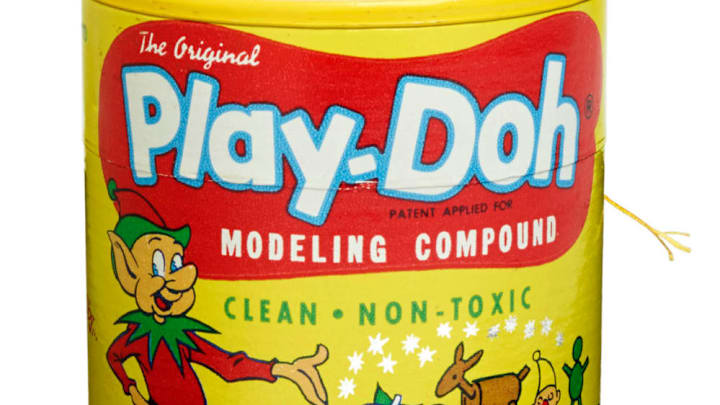The substance that would become Play-Doh actually began its life as a wallpaper cleaner. Join us as we take a brief look back at some early cans and playsets.

The substance that would become Play-Doh actually began its life as a wallpaper cleaner. We have Joe McVicker to thank for turning it into a sculpting material: In 1955, when he learned that the modeling clay used in a Cincinnati, Ohio school was too tough for kids to work with, he took another look at the cleaning product he manufactured and thought it would be better. He shipped some to the school, where it was well-received. After that, he sent it to all Cincinnati schools—and the rest is history. By 1956, Play-Doh was being sold in stores. This vintage can, which dates to 1959, features an elf.

Play-Doh was initially offered in just four colors: red, blue, yellow, and white (these days, there are more than 50 Play-Doh colors). In 1960, the elf was replaced by a boy wearing a beanie—a.k.a. Play-Doh Pete. This can dates to 1968.

By 1974, the logo had evolved again: Pete lost his body to become just a head on a can (he kept his beret until 2002; it was replaced by a baseball cap). But the can itself got its most major overhaul in 1986, when the cardboard that had been used to package the compound for 30 years was replaced by that bright yellow plastic can.

Play-Doh debuted its first playset, the Play-Doh Fun Factory, in 1960. Seventeen years later, future hairdressers got a chance to hone their craft using the Fuzzy Pumper Barber and Beauty Shop Playset. All they had to do was place the figurines in a chair and turn the crank—which caused their customers' Play-Doh hair to sprout—then use the provided tools to give the customers a cut or a shave.

Play-Doh debuted its first playset, Play-Doh Fun Factory, in 1960. Nineteen years later, the Dr. Drill N' Fill playset hit shelves. As you can see from this commercial (which has a very catchy jingle), future dentists made their patient teeth using Play-Doh, then drilled and filled his cavities. If you had Dr. Drill N' Fill and are feeling nostalgic, you're in luck: The playset got a 2016 update.This story has been updated for 2020.
